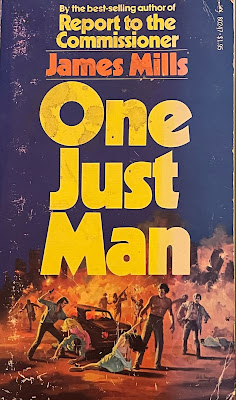F.M. Parker (Fearl Parker) worked in factories as a laborer, herded sheep, served as a bellhop, served in the Navy and is a Korean War vet. After earning a degree in geology, Parker went into mining, oil drilling, and a long career within the Bureau of Land Management. He became a full-time author, penning over 20 westerns beginning with his novel Skinner in 1981. New to his writing, I wanted to experience the author with one of his bestselling novels, Coldiron. It was originally published in 1984 and led to four subsequent novels starring the Luke Coldiron character. It remains available in ebook under the title Coldiron: Judge and Executioner.What is interesting about the Coldiron series is that the order of the books really doesn't matter after the second installment, Shadow of the Wolf (1985). The books jump around in time, for example Coldiron begins in 1843 but covers a 20 year time period until 1863. The second installment, Shadow of the Wolf, is set in 1864. Distant Thunder, aka Thunder of Cannon, the series fourth installment, is set in 1862. Spoils of War, aka The Thieves, is in 1846. Basically, one could just jump around in the series because the past doesn't matter too much. All you really need to know is that Coldiron owns a large horse ranch (The Steel Trap Brand) in what was then known as the Colorado Territory.
At 223 pages, this Coldiron novel serves as an excellent, detailed origin story. Beginning in 1843, Parker explains that the trapping industry was nearing the end of an era. Luke Coldiron and his partner are in their fourth year of trapping in The Rocky Mountains (Sangre de Cristo). Through a wild skirmish, Coldiron's partner is killed by a gang attempting to steal furs. This ordeal forces Coldiron to help his partner's pregnant Native-American widow. This new relationship is nearing a long-term romance when she is injured by a mountain lion. She gives birth to a baby girl and then dies. Coldiron then carries the baby into the plains where he gives her to a team of settlers to raise.
Fast-forward 20 years, Coldiron has worked hard to create the best horse ranch within a 500 mile radius. He breeds horses to sell to the U.S. Army and makes great money with his Steel Trap Brand. In the novel's second act, Coldiron faces deadly horse wranglers and an odd visit from a young woman named Cris pretending to be a cowboy. It's no secret that she was the baby that Coldiron gave up. She wants to kill Coldiron for “killing” her mother. It's all a misunderstanding, but makes for an inventive narrative.
F.M. Parker's Coldiron shares similarities with the early William W. Johnstone's The Last Mountain Man, which was published the same year. Both Parker's Luke Coldiron and Johnstone's Smoke Jensen were mountain men trappers turned ranchers. Coldiron has the Steel Trap and Jensen is the Sugarloaf. Both experienced the loss of their mentors in the mountains, both face rustlers and killers, and both are tough as nails. One could say that any western hero worth his salt has all of these same characteristics and history, but the two are written in the same way.
I enjoyed Coldiron, and loved learning about his origin and how the horse ranch began. There's a small backstory dedicated to Cliff, a former alcoholic that Coldiron saved and put to work as the ranch chef. The story on Cris, the abandoned baby, was presented well and paired nicely with Coldiron's grief over her mother and his partner's murder. The duo of Cliff, Coldiron, and Cris was a great assemblage of characters with different strengths and weaknesses. If you want military-fiction, unbridled western action, a formidable hero, and realistic descriptions of the mid-1800s frontier, then Coldiron is absolutely a must-read. Honorary mention to Parker's depth of knowledge of horses and ranching. This was educational and enjoyable. Highly recommended. Get a copy of the book HERE.
Coldiron Series
Coldiron (aka, Judge & Executioner, 1984)
Shadow of the Wolf (1985)
The Shanghaiers (1987)
Distant Thunder (aka Thunder of Cannon, 1999)
Spoils of War (aka The Thieves, 2017)













